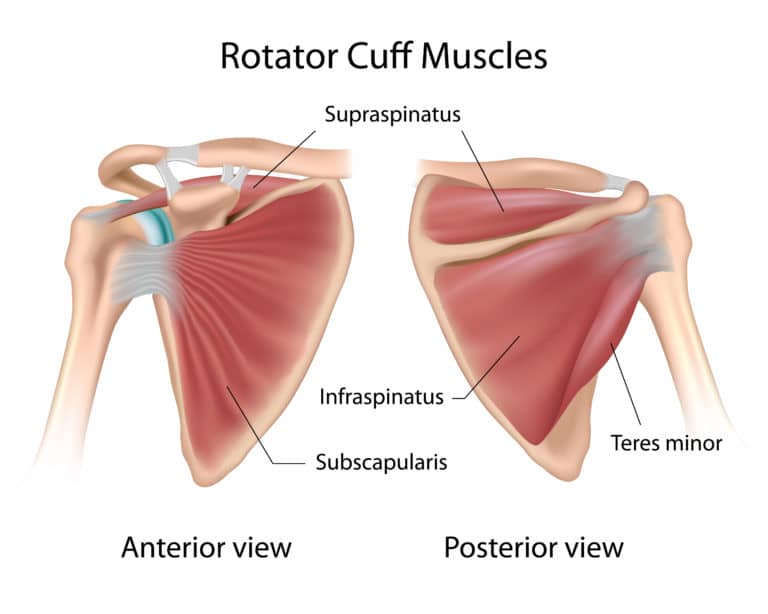Treatment Options for Rotator Cuff Tears
The rotator cuff is the anatomic name of a set of tendons in the shoulder that are critical to normal shoulder function and strength. There are four muscles that converge to form the rotator cuff. They originate from the scapula or shoulder blade. These muscles cross the shoulder joint and turn into a cuff of tendon tissue that attaches to the humerus bone on the front, top and back of the shoulder joint. As the name suggests, these muscles play an important role in the rotation and motion of the shoulder joint in all planes.

The rotator cuff can tear as a result of injury or, much more commonly, as a result of age related degeneration. If the tear is small, the symptoms can be minimal or can result in significant pain when the shoulder is put to use. Pain at night is extremely common and is often the reason patients decide to see a physician. A larger tear can cause pain and significant weakness when the arm is used away from the body or overhead.
Chronic changes that occur as a result of a rotator cuff tear can be seen on simple X-rays of the shoulder. However, an MRI is often needed to appreciate smaller tears or sudden tears of the rotator cuff. A spectrum of tear patterns and progression can be seen on an MRI, from small tears and partial fraying of the tendons to massive tears that are no longer repairable. The treatment options vary depending on the size and progression of the tears.
Treatments of rotator cuff tears include specialized physical therapy to strengthen the rotator cuff, steroid injections to minimize pain around the rotator cuff, and surgery to repair the cuff and remove any unhealthy tissue from the area.
If an individual has a rotator cuff tear that is symptomatic and the primary symptom is pain with use and/or pain at night during sleep, then that person could anticipate an 80% chance of significant pain improvement with a steroid injection and formal physical therapy. Therapy can take up to 12 weeks to improve pain symptoms. Therapy focuses on retraining the muscles around the shoulder so that they work in proper dynamics.
Steroid injections around the rotator cuff act as a potent anti-inflammatory to the area of the rotator cuff and surrounding tissues that can become inflamed. Injectable steroids are molecules related to cortisone, which is the body’s native regulator of inflammation. These injections offer a high percentage chance of pain relief for a period of time but do not replace the need for physical rehabilitation of the shoulder. Steroid injections have very low infection risks or other side effects. Although these injections do have a low risk of infection, they tend to increase blood sugars in patients with diabetes.
When surgery is required to address rotator cuff disease, it falls under two broad categories – debridement or repair.
Debridement is an option for small, partial thickness, tears of the rotator cuff or in the situation of an irrepairable tear in some individuals. Debridement means removal of tissue that is unhealthy and irritated. This is usually done arthroscopically through small poke holes in the skin where small instruments can be placed in and around the joint to see and perform the necessary work. With this procedure, post operative recovery is accelerated, requiring only a few days in a sling for comfort followed by physical therapy.
On the other hand, if the rotator cuff is surgically repaired, then recovery is more limited. Rotator cuff repair can be done arthroscopically or through an open incision depending on the surgeons preference. Recovery after rotator cuff repair is typically 4-6 weeks of sling protection, 6-8 weeks of therapy for range of motion, and 3 months of strengthening. Surgery offers an 80-85% chance of good to excellent pain relief.
In the situation of large or massive irrepairable rotator cuff tears that also develop significant arthritis, a specific type of joint replacement surgery may be an option. This is called reverse total shoulder replacement. Reverse total shoulder replacement “reverses” the normal ball and socket geometry of the shoulder joint to help replace some of the function of the rotator cuff. This surgery offers a high percentage of pain relief and improvement in function.
Rotator cuff disease is a very common cause of shoulder pain. There are good surgical and nonsurgical options for treatment of rotator cuff problems. Treatment choice is based on individual factors and disease severity. It is best to consult with an orthopaedic physician with any questions or concerns regarding shoulder pain.

Dr. Jonathan R. Pritt is fellowship trained and Board Eligible in Orthopaedic Surgery. He attended medical school at the University of Florida College of Medicine and completed his residency at the Mayo Clinic in Rochester, MN. Additionally, he obtained his fellowship training in Sports Medicine at the Steadman Hawkins Clinic of the Carolinas. Dr. Pritt practices at The Orthopaedic Institute’s Gainesville and Alachua facilities.

